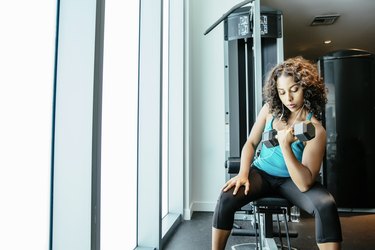
Dumbbell curls are one of the most effective and empowering exercises you can do, and with minimal equipment. All you need is a pair of dumbbells and you're ready to go. But how much should you be lifting? How many reps should you be aiming for, and most important — how do you do dumbbell curls with proper form to avoid injury?
Tip
With dumbbells in both hands, palms facing forward and your feet hip-width apart, bend at the elbow to raise the dumbbells toward your shoulders. Lower the weights back down the same way until your arms are back to their original position, then repeat.
Video of the Day
Target the Biceps
Dumbbell curls target the bicep brachii muscle, the large muscle that lies between the shoulder and the elbow. Just like all muscles in the body, they need to be trained regularly if you want them to get stronger, leaner and more toned.
Video of the Day
The American Heart Association recommends that adults engage in moderate to high-intensity strength training at least two days per week. This means strength training is a lifelong process, so if you want to maintain muscle mass throughout the years, pick up some dumbbells. But which ones?
Read more: 8 Exercises to Get Rid of Arm Jiggle
Select the Right Weights
According to the American Council on Exercise, there are many reasons you should select heavy weights instead of light ones. Lifting heavy can increase your metabolism, improve intramuscular coordination and help fight the effects of aging, but "heavy" means something different for everyone. As a general rule, with a "heavy" dumbbell you can do eight to 12 reps with proper form, becoming fatigued by the last repetition.
Many women are hesitant to lift heavy because they do not want to become too muscular, but as the Office of Women's Health points out, women's bodies naturally have more fat than men's bodies, so it is unlikely for a woman to get bulky unintentionally from lifting heavy weights.
Read more: Why Do My Muscles Hurt After Lifting Weights
Correct Bicep Curl Form
Once you've selected your weights, it's time to get your form down:
- Stand with your feet hip-width apart with a dumbbell in each hand. Bend your knees slightly, engage your core and maintain good upright posture.
- Position your arms so that your palms are facing forward. Hold onto the dumbbells, but don't grip them so tightly that you feel strain in your forearms.
- Bending at the elbow, lift both dumbbells up toward your shoulders by flexing your bicep muscles. Lower the dumbbells the same way you raised them until your arms are fully extended in the same position you started in.
- Repeat eight to 12 repetitions without swinging your weights. In other words, rely on your muscles rather than momentum. If you find yourself needing to add momentum to lift, try using a slightly lighter dumbbell instead, as swinging can lead to injury.
Try More Arm Exercises
Dumbbell curls are fantastic, but they are just one of many effective exercises to target the bicep muscles. In 2014, the American Council on Exercise published a study indicating other top-performing bicep exercises, including cable curls, preacher curls and incline curls. Once you get standard dumbbell curls down, try switching it up for added strength benefits.
- American Heart Association: "American Heart Association Recommendations for Physical Activity in Adults and Kids"
- American Council on Exercise: "Why You Should Be Lifting Heavy"
- Office of Women's Health:"How to Be Active for Health"
- American Council on Exercise: "ACE Study Reveals Best Biceps Exercises"